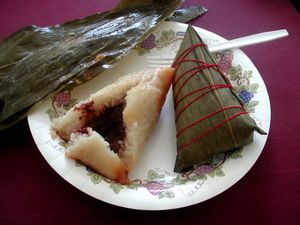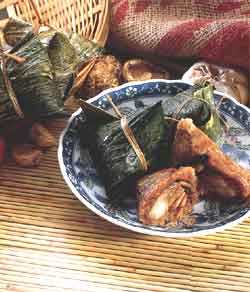 What is Bak Chang? I think it is Hokkien for Rice Dumpling. In Hakka, I know it as “Chung”, or Cantonese as “Chuong”. It’s the time of the year again, when I see people eating and/or selling Bak Chang. Is it a Chinese thingy? How come I don’t know much about it? Am I losing my Chinese heritage? As a young one, I recall my mum making Bak Chang, and I do like the taste of home made ones. I have tried buying in KL before, but nothing really matches the quality of home made ones. I love the ones with “lap cheongs”! Sluuurrppp!!! :P
What is Bak Chang? I think it is Hokkien for Rice Dumpling. In Hakka, I know it as “Chung”, or Cantonese as “Chuong”. It’s the time of the year again, when I see people eating and/or selling Bak Chang. Is it a Chinese thingy? How come I don’t know much about it? Am I losing my Chinese heritage? As a young one, I recall my mum making Bak Chang, and I do like the taste of home made ones. I have tried buying in KL before, but nothing really matches the quality of home made ones. I love the ones with “lap cheongs”! Sluuurrppp!!! :PSo, a bit of history (source: Wikipedia). The origins of rice dumplings are traced to the legend of Qu Yuan, a well-loved poet who drowned himself in a river. To stop the fish from eating his body, people made rice dumplings and threw them into the river. Another version of the legend states that the dumplings were made to placate a dragon that lived in the river. Rice dumplings are made for the Dragon Boat Festival, which falls on the fifth day of the fifth month of the Chinese calendar.
 How is it made? I have no idea, and have never tried, but it is interesting to find out. The fillings for the dumplings vary from region to region but the rice used is always glutinous rice (also called "sticky rice"). Depends on the region, the rice may be precooked or only soaked before using. Fillings may be sweet, such as mashed yellow beans, or savoury, and may include pork, sausages, Chinese mushrooms, salted egg, and chestnuts. Some types of bak chang contain no filling at all, in which case they are usually eaten with sugar or syrup.
How is it made? I have no idea, and have never tried, but it is interesting to find out. The fillings for the dumplings vary from region to region but the rice used is always glutinous rice (also called "sticky rice"). Depends on the region, the rice may be precooked or only soaked before using. Fillings may be sweet, such as mashed yellow beans, or savoury, and may include pork, sausages, Chinese mushrooms, salted egg, and chestnuts. Some types of bak chang contain no filling at all, in which case they are usually eaten with sugar or syrup.The rice dumpling is usually a pyramid of rice which encloses the filling and wrapped in dried (or more rarely fresh) leaves (I have seen some elongated shaped ones though). Bamboo leaves are perhaps the most common. Wrapping a dumpling neatly is a skill which is passed down through families, as are the recipes.
Dumplings may also be frozen for later consumption, but must be boiled instead of steamed when stored in this fashion. Now this I didn’t know! What I would normally do is put it in the microwave and wait for the “PING”!
There are quite a few Bak Chang recipes online if you care to search, but I think I will wait for some my friends who may be lucky enough to have home made ones to ask me over to makan. So, anyone? :)
2 comments:
Bak chang festival... Not an easy task to make. :)
Was fortunate enough that one Melaka frd gave me 3 nyonya chang which is supposed to be "half salty and half sweet" = convert to cantonese. Tdy received another one fr a collegue (a common chang)
Eaten one of the nyonya chang and gave one away so left 2. Got gastric yesterday, perhaps you would like to have the other 2... Both are home made ones!!!
Danke! :)
Post a Comment